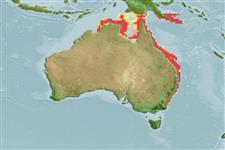Environment: milieu / climate zone / depth range / distribution range
Écologie
marin; saumâtre benthopélagique; profondeur 1 - 40 m (Ref. 86942). Tropical; 9°S - 37°S, 129°E - 155°E (Ref. 114953)
Western Central and Southwest Pacific: endemic to eastern and northern Australia (Ref. 114953).
Taille / Poids / Âge
Maturity: Lm ? range ? - ? cm
Max length : 130 cm TL mâle / non sexé; (Ref. 9840); poids max. publié: 6.1 kg (Ref. 40637)
Found in mangrove swamps and estuaries (Ref. 9840). Feeds on shellfish (Ref. 6871), worms, crabs and other crustaceans (Ref. 114953). Size could possibly reach 160 cm DW (Ref. 114953). Ovoviviparous (Ref. 50449). Maturity size ca. 41 cm WD (males) and 63 cm WD (females); hatch size ca. 11 cm WD (Ref. 114953).
Life cycle and mating behavior
Maturité | Reproduction | Frai | Œufs | Fécondité | Larves
Exhibit ovoviparity (aplacental viviparity), with embryos feeding initially on yolk, then receiving additional nourishment from the mother by indirect absorption of uterine fluid enriched with mucus, fat or protein through specialised structures (Ref. 50449). Distinct pairing with embrace (Ref. 205).
Mould, B., 1994. A world list of rays. The scientific nomenclature and distribution of the recent Batoidea (Batoidea, Elasmobranchii, Chondrichthyes). University of Nottingham, [UK]. 82 p. (Ref. 8630)
Statut dans la liste rouge de l'IUCN (Ref. 130435: Version 2024-1)
Menace pour l'homme
Harmless
Utilisations par l'homme
Pêcheries: intérêt commercial mineur; pêche sportive: oui
Outils
Articles particuliers
Télécharger en XML
Sources Internet
Estimates based on models
Preferred temperature (Ref.
123201): 26.9 - 29, mean 28 °C (based on 130 cells).
Phylogenetic diversity index (Ref.
82804): PD
50 = 0.5010 [Uniqueness, from 0.5 = low to 2.0 = high].
Bayesian length-weight: a=0.00468 (0.00195 - 0.01123), b=3.12 (2.92 - 3.32), in cm total length, based on LWR estimates for this (Sub)family-body shape (Ref.
93245).
Niveau trophique (Ref.
69278): 3.6 ±0.50 se; based on food items.
Résilience (Ref.
120179): Faible, temps minimum de doublement de population : 4,5 à 14 années (Assuming fecundity<100).
Fishing Vulnerability (Ref.
59153): Very high vulnerability (78 of 100).
